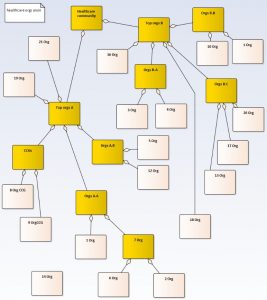This page summarises a successful engagement with over 20 healthcare organisations during the second half of 2016.
Overview
The engagement with this healthcare community was driven by a conviction that application of systems engineering and system thinking approaches could provide real insight into the challenges of achieving improvement in the ‘wicked’ problem area that is healthcare. During 2016, Holistem had the opportunity (with two other INCOSE colleagues) to work with a multi-disciplinary group of healthcare representatives from over 20 organisations to assist their journey of improving using a number of systems approaches. Organisations include many departments within the UK NHS, but also included other groups (social services, ambulance service, voluntary service…).
A reference that provides useful context to the engagement is the NHS Five Year Forward View [2014] available here.
Workshop objectives and rationale
The workshops were aimed to get overy one across a range of organisations ‘on the same page’, to understand their role on ‘the bigger picture’, and potentially help break down ‘silo working’.
The use of the techniques generically served multiple purposes:
- Supported dialogue across stakeholders and disciplines, enabling all stakeholders to see the wider perspective;
- Ensured each contributor’s voice is heard, avoiding certain personalities being dominant;
- Brought in valuable visualisations that stakeholders may not previously have been aware of, and that provided new insights into the improvement domain.
The techniques are complementary to others traditionally used in healthcare improvement:
- Lean (elimination of waste in repetitive processes)
- PDSA – Plan, Do, Study, Act – improvement cycles
…in particular bringing a systemic perspective.
Some techniques were applied before or after the workshops (causal loop modelling, concept modelling, topic clustering…), while others where applied within the workshops, as part of facilitation (round tables, prioritisation…). Where a technique was used prior to a workshop, the output of that technique (for instance a causal loop diagram, or systemigram) acted as focus for part of the discussion in a subsequent workshop. (The diagram below only shows the three online workshops. and does not show offline activities, before or after the workshops).
The healthcare workshops
The engagement used a sequence of workshops (see figure below), each making use of a number of techniques. Some techniques were used within the workshops, while other techniques were used offline of the workshops, before or after. The techniques themselves are described here.

The pre-workshop meeting agreed to focus on the topic are of healthcare supporting ‘frail and elderly’ patients, or more succinctly ‘frailty’. This enabled some initial preparation for Workshop 1, using Causal Loop Modelling and Concept Modelling (see Techniques for examples).
Workshop 1 primarily used a Round Table approach, to collect both Issues and Opportunities. These were subsequently organised, using Clustering and Thematic Analysis. In addition, an N-Squared approach was used to visualise inter-organisation interactions. (why? makes it easier to see systemic issues with inter-organisation interactions). Offline, the techniques thematic analysis and clustering were used to organise Issues and Opportunities. In preparation for workshop 2 concept modelling was used to draw up a structured view of all the organisations represented at the workshops – not ‘rocket science’ but useful to the subsequent attendees. Systemigrams diagrams and causal loop models were also produced, inspired by “Mrs Andrews Story”, an animation available here.

At workshop 2 the issues and opportunties from Workshop 1 were refined and validated. The workshop also made use of the Systemigrams diagrams and causal loop models to stimulate further input, and to ensure everone was ‘on the same page’. Power-workshop 2, issues and proposals for improvement were further analysed (~60 issues, ~100 proposals), to prepare for Workshop 3. Clustering into different categories helped to organise proposals into categories: Person focus, Organisation Integration, Information Sharing, Decision Making and Techn ology Exploitation.
Workshop 3 built on the outcomes from the previous workshops, by using a prioritisation approach, to focus on a subset of proposals, and to organise them into a proposal architecture: short term with substantial early benefits, medium term tackling more complicated topics, and longer term addressing complex topics.
Overall outcome
The engagement achieved for the participants:
- an understanding of the bigger cross-organisational picture;
- concrete improvement proposals traceability back to the issues raised;
- mutual benefit to both healthcare organisations (proposed improvements) and INCOSE (systems techniques applied in healthcare).